
Mechelen is a city and municipality in the province of Antwerp in the Flemish Region of Belgium. The municipality comprises the city of Mechelen proper, some quarters at its outskirts, the hamlets of Nekkerspoel (adjacent) and Battel, as well as the villages of Walem, Heffen, Leest, Hombeek, and Muizen. The river Dyle (Dijle) flows through the city, hence it is often referred to as the Dijlestad.
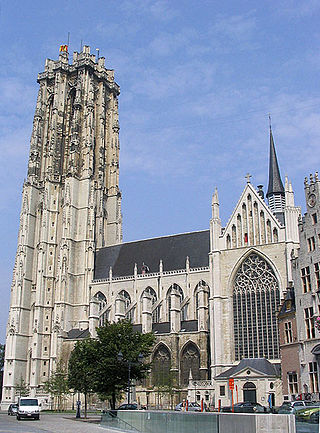
St. Rumbold's Cathedral is the Roman Catholic metropolitan archiepiscopal cathedral in Mechelen, Belgium, dedicated to Saint Rumbold, Christian missionary and martyr who founded an abbey nearby. His remains are rumoured to be buried inside the cathedral. State-of-the-art examination of the relics honoured as Saint Rumbold's and kept in a shrine in the retro-choir, showed a life span of about 40 years and a death date between 580 and 655, while tradition had claimed 775 AD.

Julien Gorius is a former French professional footballer who used to be sporting director for RWDM47 in the Belgian First Division B.

Mayken Verhulst, also known as Marie Bessemers, was a sixteenth-century miniature, tempera and watercolor painter, identified by Lodovico Guicciardini in 1567 as one of the four most important female artists in the Low Countries. She was actively engaged in the workshop of her husband, Pieter Coecke van Aelst, posthumously publishing his works. While she is recognized as an exceptionally skilled artist, little is known about her works or life as there are few surviving attributable sources of information.

Lucas Faydherbe was a Flemish sculptor and architect who played a major role in the development of the High Baroque in the Southern Netherlands.
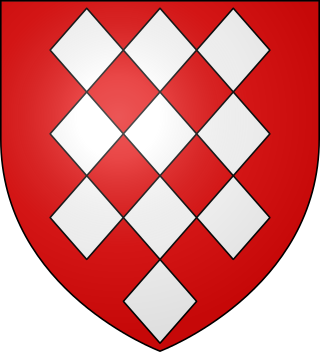
Antoine I de Lalaing (1480–1540), 1st count of Hoogstraten and of Culemborg, was a Hainautese nobleman who held various offices in the court of the Dukes of Burgundy.
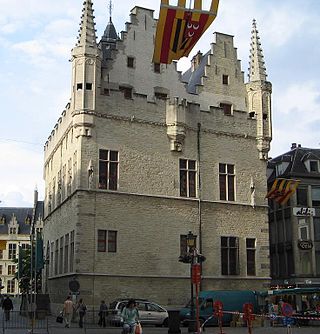
From the 15th century onwards, the Great Council of the Netherlands at Mechelen was the highest court in the Burgundian Netherlands. It was responsible for the Dutch-, French- and German-speaking areas. In Luxembourgish the phrase "mir ginn op Mechelen" still means playing one's last trump card. The Grote Raad first sat in the Schepenhuis in Mechelen then, from 1616, in the (old) palace of Margaretha of Austria on Keizerstraat.
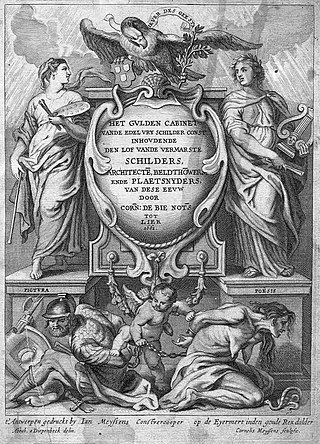
Het Gulden Cabinet vande Edel Vry Schilder-Const or The Golden Cabinet of the Noble Liberal Art of Painting is a book by the 17th-century Flemish notary and rederijker Cornelis de Bie published in Antwerp. Written in the Dutch language, it contains artist biographies and panegyrics with engraved portraits of 16th- and 17th-century artists, predominantly from the Habsburg Netherlands. The work is a very important source of information on the artists it describes. It formed the principal source of information for later art historians such as Arnold Houbraken and Jacob Campo Weyerman. It was published in 1662, although the work also mentions 1661 as date of publication.

Brabantine Gothic, occasionally called Brabantian Gothic, is a significant variant of Gothic architecture that is typical for the Low Countries. It surfaced in the first half of the 14th century at St. Rumbold's Cathedral in the city of Mechelen.
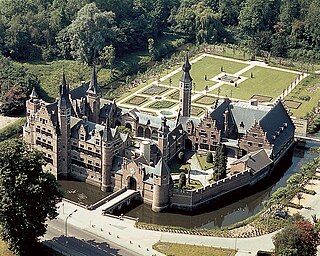
The Sterckshof castle is in Deurne, Antwerp, Belgium. From 1994 to 2014 it housed the Sterckshof silver museum of the Province of Antwerp. Built on the site of a much older castle, or great house, the present building is a reconstruction erected in the 1920s.

Clous van Mechelen is a Dutch musician, arranger, and actor. Van Mechelen scored a minor hit in 1969 with his band The Butlers, and became widely known through the radio and television shows written and directed by Wim T. Schippers, in which he played the character Jan Vos and wrote songs for the various characters.
Henry Jaye was an English Catholic exile in the Southern Netherlands. He became printer to the city of Mechelen.

Jan Baptist Jozef de Bay, known as Jozef de Bay and Jean Baptiste Joseph de Bay the Elder, signed as De Bay Père was a Flemish sculptor, museum conservator and art restorer. After training in Mechelen, Nantes and Paris, he spent most of his active career in France where he executed many portrait sculptures in a classicist style. He became conservator of the collection of antique sculptures of the Louvre.
The 2018–19 season of the Belgian First Division B began in August 2018 and ended in April 2019. It was the third season of the First Division B following a change in league format from the old Belgian Second Division.

The Church of St. John the Baptist is a Roman Catholic parish church located in the centre of Molenbeek-Saint-Jean, a municipality of Brussels, Belgium. It is dedicated to Saint John the Baptist, the patron saint of Molenbeek.

Jan Frans van Geel was a Flemish sculptor, draugthsman and art educator. He is mainly known for his church furniture, statues of saints, mythological ensembles and allegorical figures. He was a teacher and director at the Academy of Arts of Mechelen and teacher of sculpture at the Academy of Arts of Antwerp. He was one of the last Flemish sculptors who worked in the Flemish Baroque style in sculpture, which was popular in the Habsburg Netherlands in the 17th and 18th centuries.

Jan Baptist de Smet was the 14th Bishop of Ghent and the 15th Bishop of Ypres.
Jan van Lokeren was a Flemish sculptor and woodcarver mostly active in Mechelen.

The Schepenhuis of Mechelen, Flemish Brabant, Belgium, is a building where the city's aldermen held their meetings in the Middle Ages. It is located on the edge of the Grote Markt, between the latter and the IJzerenleen and is considered the first stone 'town hall' of Flanders.

The Oratorian College in Mechelen was a Latin school that was run in the city of Mechelen by the Congregation of the Oratory from 1630 to 1796. Originally founded in the Middle Ages by a collegiate church, management was transferred to the civic magistracy in 1450 and to the Oratorians in 1630. The school was closed down by occupying French revolutionary forces in 1796. The 18th-century building of the Oratorian College is preserved as a listed monument.















